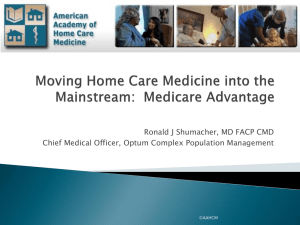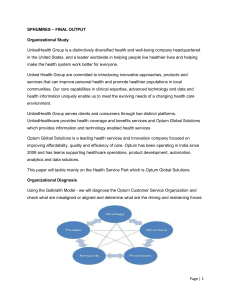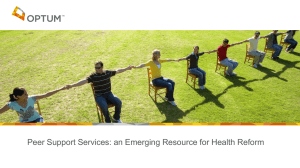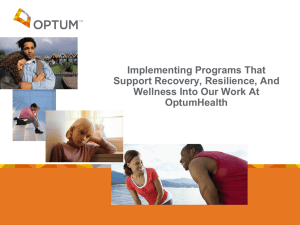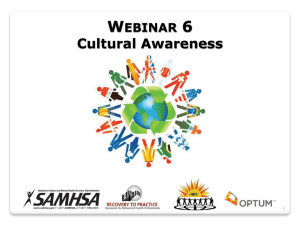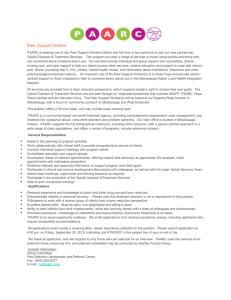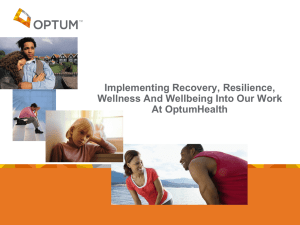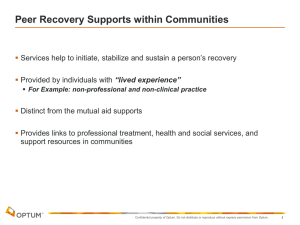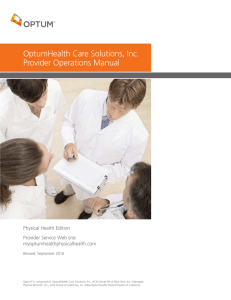PPTX, 1.33MB - National Association of State Alcohol and Drug
advertisement
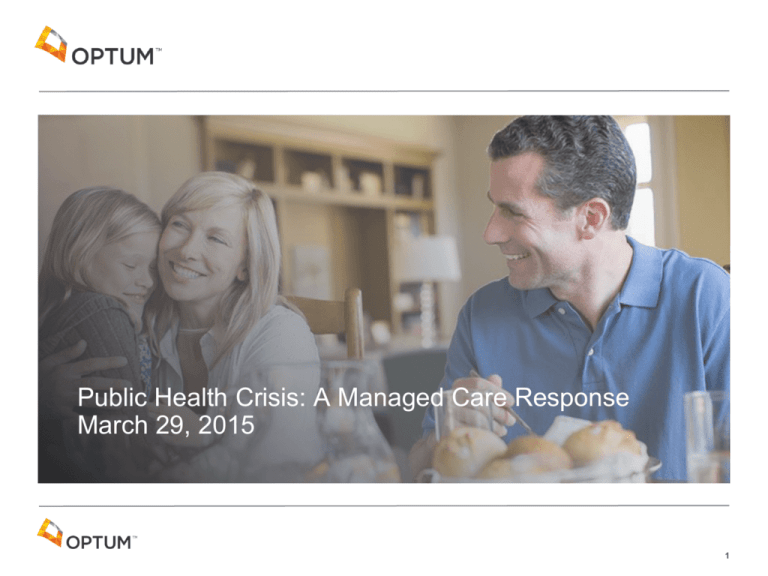
Public Health Crisis: A Managed Care Response March 29, 2015 1 Dona M. Dmitrovic, MHS Director for Consumer Affairs, Substance Use Disorders 2 Addressing a Public Health Crisis: Opioid Dependence SCOPE OF THE PROBLEM MANAGED CARE PERSPECTIVE 3 What our Data Shows: • Increase of 41% in overall costs for young people over the past two years significant to opioid use. • Key driver of the general increase in opiate treatment due to the combination of both prescription drug misuse and illicit drug use. • From 2004 to 2011 there has been a 423% increase in U.S. emergency room costs relating to: – 21% increase of illicit drug use – 56% increase due to misuse/abuse of pharmaceuticals – 46% increase due to adverse reactions 4 Consequences of opioid abuse among young adults: • Emergency room visits have more than doubled related to non-medical use of opioid pain relievers for young adults. • Ages 18 to 24 increased from 20,000 to 49,000 from 2004 to 2009. 1. Meier B, Marsh B, The Soaring Cost of the Opioid Economy. NY Times, Sunday Review, June 22, 2013. 2. Rates reflect increases in illicit drug use and misuse/abuse of pharmaceuticals from 2004 to 2011, and increases in adverse reactions from 2005 to 2011, as reported in: Substance Abuse and Mental Health Services Administration, Center for Behavioral Health Statistics and Quality. (2013). Treatment Episode Data Set (TEDS): 2001-2011. State Admissions to Substance Abuse Treatment Services. BHSIS Series S-68, HHS Publication No. (SMA) 14-4832. 3. National Institute on Drug Abuse/Substance Abuse and Mental Health Services Administration: The Blending Initiative. Buprenorphine Treatment for Young Adults: Fact Sheet. Retrieved from http://www.drugabuse.gov/sites/default/files/ files/BupTx_YngAdlts_Factsheet.pdf 5 Health Care Costs – Drug Use • $4.5 billion in health expenditures – 10% used for treatment of addiction – 15% of those meeting criteria for addiction are referred to treatment • 85,000 deaths attributable to alcohol misuse – Third leading cause of preventable deaths in the U.S. • Motor vehicles are the leading cause of death for adolescents – 37% of traffic deaths among youth involve alcohol • Unintentional poisoning mortality rate increased by 128% (2000-2009) – 74% were overdoses of prescription opioid analgesics 6 Health Care Costs – Drug Use • Substance misuse plays a contributing role in physical health: – CV – GI – CA – Neurologic – Infectious 7 Initial Identification of Substance Use Disorders • Medical – General hospital 23% – Family practice 12% – Emergency medicine 11% – Internal medicine 9% – Specialists/other 5% • Behavioral – Psychiatric hospital 19% – Social workers 8% – Psychiatrists 5% – Psychologists 3% – Substance use treatment 2% – Mental health clinic 1% 8 Substance Use Disorder • Public health crisis – Results in major economic and social burdens • Treatment has same efficacy as treatment of other chronic disorders • Prelavence and incidence – Is present in all socieconomic, cultural and ethnic groups • Health care management has become a focus of quality management 9 Addressing a Public Health Crisis: Opioid Dependence RECOVERY AND RESILIENCY MANAGED CARE PERSPECTIVE 10 Optum’s Clinical Model These are three faces of quality making us, at the core, a quality improvement company. We manage by way of 3 core competencies or “pillars”. A focus on consumer and family engagement, implementing the evidence-based techniques from the field of recovery and resilience, is integral to each of the pillars. Confidential property of Optum. Do not distribute or reproduce without express permission from Optum. 11 11 Commitment to Recovery Recovery and resiliency starts with the consumer: ✓ ✓ ✓ ✓ ✓ ✓ Goals Dreams Strengths Family Culture Ideas Every child, youth, adult and elder has the right to live in their community with health, dignity and hope. 12 Recovery and Resiliency • OptumHealth Behavioral Solutions is committed to the principles of recovery and resiliency. • Providers are supported to become recovery and resiliency oriented and to incorporate these principles into practice. • Systemic support for recovery and resiliency for consumers and families. • Optum believes that quality comprehensive care requires strong medicalbehavioral integration • Providing both contracted and community services allows consumers to remain in their home setting and assists them in long term recovery 13 Empowering members and their families today Family Member Provider Support the family, build recovery capital for the member Support recovery and resiliency Provide engagement and support for their patients and families • Family-to-family peer support pilot • Emerging peer coaching capability • Empowerment and selfmanagement tools • Empowerment and selfmanagement tools • Online tools and resources • Online tools and resources • Toolkits and resources for providers to share with members and families • Person-centered treatment planning: training and coaching programs • Webinars and support groups 14 Goals for Assisting Consumer and Families • Listen and hear what consumers and customers want. • Advocate for recovery and resiliency and self-direction • Empower consumer and family to make their own decision • Educate consumers, family, communities and providers • Ensure access to services to all • Support community efforts around substance use • Increase acceptance and reduce stigma for those with behavioral health needs 15 Optum’s Approach AATOD Conference March 29, 2015 16 Optum’s Medication Assisted Treatment Objectives • Increase referrals to existing providers and facilities that offer medication assisted treatment services • Increase number of facilities offering these services in geographic areas • Reduce inpatient/residential admits where medication assisted treatment/ambulatory programs exist • Decrease readmission rates • Increase community tenure with long term recovery support services 17 17 Materials for Members • Fact Sheets for members and family members 18 Tools & Resources Supporting Recovery 19 The Science of Peer Support Services - Does it work? • • • What peer support appears to be able to do more successfully than professionally qualified staff is promote hope and belief in the possibility of recovery; empowerment and increased self-esteem, self-efficacy and self-management of difficulties and social inclusion, engagement and increased social networks. It is just these outcomes that people with lived experience have associated with their own recovery; indeed these have been proposed as the central tenets of recovery: hope, control/agency and opportunity (Repper and Carter, 2011) Mark S. Salzer, Ph.D., in his work with the Mental Health Association of Southeastern Pennsylvania Best Practices Team, reports that his research on mental health peer support indicates that it is associated with decreased symptoms, increased coping skills, and increased life satisfaction among long-term versus short-term members (2002). Consumers participating in peer support had better adherence to medication regimens (Magura, S., Laudet, A., Mahmood, D., Rosenblum, A. & Knight, E.), had better healing outcomes, greater levels of empowerment, shorter hospital stays and less hospital admissions (which resulted in lower costs than control group). (Dumont, J. & Jones, K. 2002) 20 20 Optum Research on Peer Supports • Enrollees in the Wisconsin PeerLink program showed a significant decrease of 71% in average number of acute inpatient days per month • Enrollees in the Tennessee PeerLink program showed a significant decrease of 90% in average number of acute inpatient days per month • Optum Texas showed a 70% reduction in hospital days • Optum Pierce County, Washington showed that for 125 people, 79.2% reduction in hospital admission year over year with a $550,215 in savings. • NYAPRS data showed 71% percent of the people involved with Peer Bridgers were able to stay out of the hospital in 2009 • Recovery Innovations: 56% reduction in hospital readmission rates. 21 Recovery Support Services for MAT • Empower individuals to achieve ongoing, sustained recovery • Engagement into counseling and/or other community resources • Development of recovery plan based on recovery capital • Provided within the primary care office or a community program • Coordinates services for members to live independently, become stabilized both physically and emotionally • Address education and vocational needs 22 Outcomes of RCO Buprenorphine Program • No readmission for 297 of the 337 members involved to inpatient treatment • 88% remained free from opioid dependence • 60% successfully completed their outpatient treatment program • Cost savings was over $320,000 for the year • Team approach with member, recovery coach, physician, therapist (if appropriate), pharmacist and family members (if appropriate). 23 Thank you Confidential property of Optum. Do not distribute or reproduce without express permission from Optum. 24
